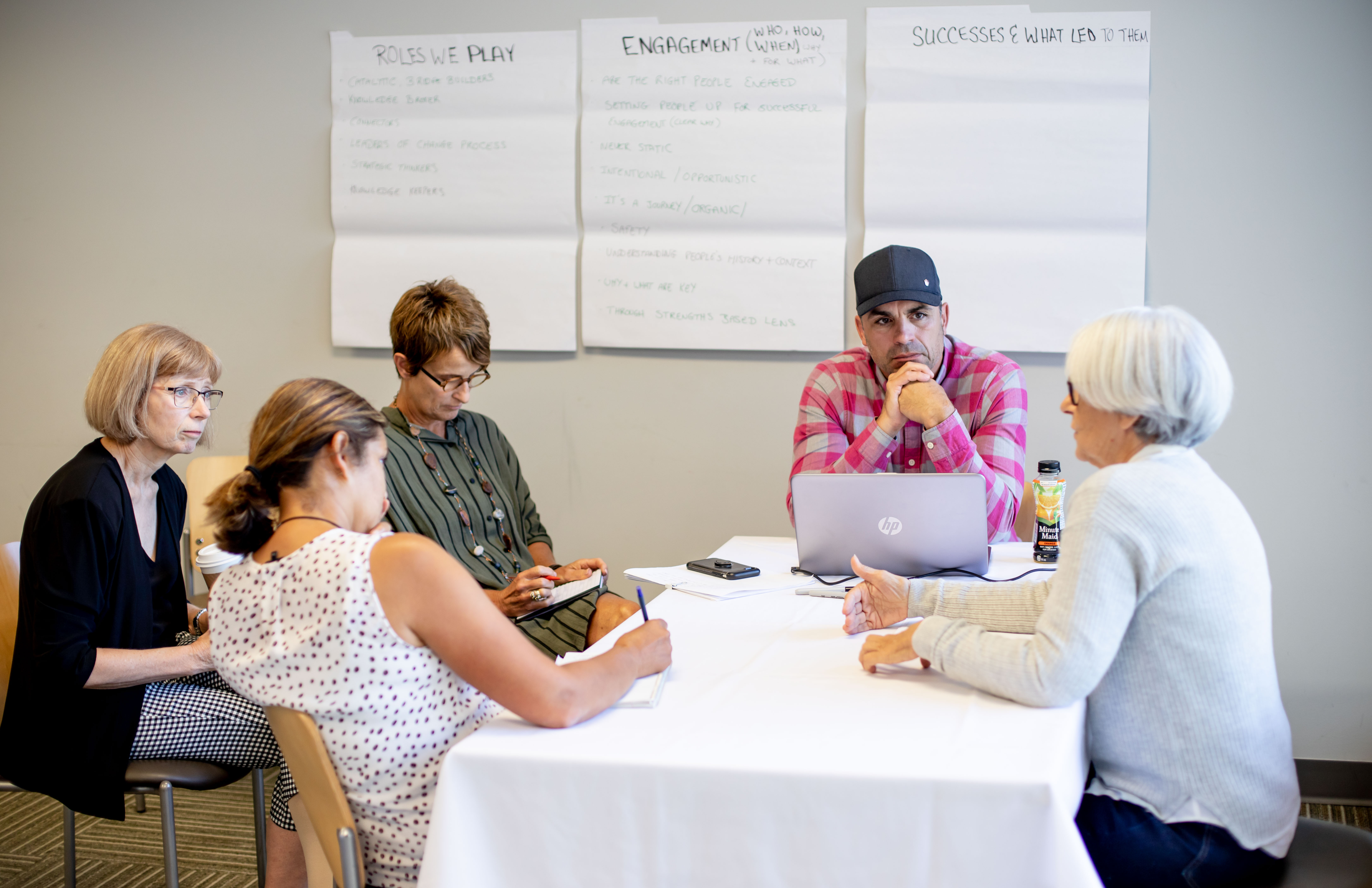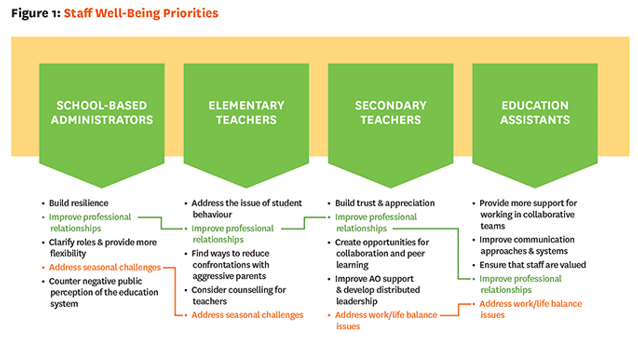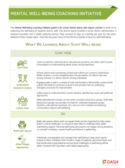Looking to get started with workplace well-being? (419.84 kB / pdf)
Check out what three B.C. school districts have learned!
Download
By: DASH, Charlie Naylor
Date: September 23, 2019
For more information about DASH, check out: www.dashbc.ca
For updates, follow DASH on Twitter: @DASHBC

While many school districts support addressing students’ social-emotional learning (SEL) and mental health initiatives for students, far fewer districts have a significant focus on the mental health of their staff. Yet a plethora of research shows that there exists a strong rationale for addressing staff well-being. Poor staff mental health may impact students’ well-being and ability to learn, so supporting staff well-being benefits students. In addition, the human and financial costs incurred from treating staff psychological disorders in Canada are significant. Sisak et al argued:
“If teachers’ own mental health needs are neglected, they may be unable or unwilling to consider mental health problems of the young people they teach. When teachers’ emotional health is in jeopardy, it reduces their ability to support and respond to pupils appropriately, which creates further difficulties within the classroom and more emotional distress for pupils and teachers alike.”
SO WHY THE FOCUS ON ALL STAFF?
A school district is a highly interactive community. All staff members should be a focus of well-being approaches, because each person is one part of the whole and each can impact or be impacted by other staff, students and parents at different times. Whether a teacher, an administrator, a special education assistant, a bus driver, a janitor, or a secretary, each person interacts to varying degrees with students, other staff and parents. We need the whole community to be healthy.
Educators and others working in K-12 systems are not health-care professionals. We do not diagnose or treat physical or mental health issues. But what we can do is to maximize the well-being of staff by creating supportive and caring communities in which we work, thereby reducing the possibility of negative mental health issues arising. It’s possible to build on the positive and address some issues that may be problematic in a variety of ways in order to improve staff well-being.

THE B.C. EXPERIENCE
British Columbia has multiple government, union, and employer well-being/mental health initiatives, and what I will share is a very small piece of that overall picture. What follows are some initial learnings from three B.C. school districts where I have worked as a Coach with district well-being teams. These teams, consisting of one senior administrator, one district-wide staff person, and one health authority representative, are part of an initiative funded by the McConnell Foundation, and led by DASH Dedicated Action for School Health, to support B.C. school districts in their approach to promoting mental well-being for students and staff.
This infrastructure of external funding and support has been crucial, and a major factor supporting staff wellness approaches.
- The Coach is a “critical friend” to the district team, aiming to support and enhance staff well-being by providing a neutral perspective, asking critical questions, and ideally engaging in dialogue with management, unions, Professional Development Chairs, and a range of committees.
- Funding for Coaches’ time and travel, at no cost to the districts involved, has created tangible supports for several school districts.
Dr. Charlie Naylor, Mental Well-Being Coach for DASH – Dedicated Action for School Health, discusses how leading focus groups can allow school districts to co-create clear visions and priorities alongside staff.
KEY FINDINGS AND EARLY ACTION STEPS
Figure 1 summarizes priorities for action based on data from four focus groups in one B.C. coastal school district.

While a range of staff identified what might be considered traditional well-being approaches like resilience, addressing seasonal challenges and work-life balance, we were surprised by the focus on improving professional relationships across all four focus groups. This suggests that with the high levels of staff interaction, staff felt that communications and dialogue could be significantly improved, and that such improvement would promote well-being. From elementary teachers there was a strong focus on the need for greater support in addressing student behaviour.
While the focus group data and staff’s recommendations for priorities provided a foundation for action, we also had to consider how to proceed.
School district teams discuss the importance of effective communication and dialogue in leading a district-wide staff well-being initiative.
HOW TO MOVE FORWARD?
If you have ever been surveyed or participated in a focus group, you may have felt that once you had provided your input, some action might reasonably follow. You may have been frustrated that action did not happen as you’d expect. So having asked close to a hundred staff what helps or hinders their well-being, and what they would like to see happen, we as a district team were keen to avoid the “We told them but nothing happened” scenario. What we came up with emerged in part from the early, wide-ranging discussions about approaches to well-being with unions and management. It’s simply this: It’s not just up to the individual teacher, administrator or support staff worker to become more resilient. Neither is it up to the district to “fix” everything. It’s a combination, with individuals, groups and the district playing different roles but all having the potential to take some action. So we have proposed:
Individual approaches: what each person might consider. One example of this was a teacher who read the Educational Assistants’ (EAs) Focus Group report, outlining some data showing that EAs often did not feel included in their school. He added the EA’s name alongside his name on a label on his classroom door. It’s a simple step that takes no time and costs nothing, but addresses the issue and potentially supports EA well-being.
Collaborative approaches: what a group may choose to explore. One small elementary school group started an inquiry group to address well-being. Other options could be a group starting an exercise program or having more social events in their school, like lunches where all staff are invited.
Collective approaches: what might be considered by a district. In one district, where professional interactions were stated as problematic in all focus groups, the district provided some funding for participation in a university Symposia series offered by Simon Fraser University, which aims to improve dialogue in public education, and to enable any staff to engage more productively in conversations and dialogue with peers.
Dave Strange, Associate Superintendent at Sooke School District, outlines the role of school district leadership in supporting staff mental health and well-being.
What may evolve from these approaches is that all staff could be encouraged to consider what actions they can take as individuals or in groups. School districts might enable actions of their staff through funding and support. Everyone can play a role, and there is no expectation that someone else will fix everything. Participation in any actions to address staff well-being would be voluntary. Stress-inducing issues such as student behaviour and professional interactions would be addressed with district financial support, but with staff leading the changes taking place.
Because of district budget cycles and timelines, there was a priority focus on collective approaches (district actions) in one district, with the focus on individual and collaborative steps coming later. However, in the two other districts where I work, there are significant steps to create collaborative actions in schools, with a wide range of learning groups in one district and the creation of “wellness champions” in each school who act as conduits for information and catalysts for action in a second district.
Gail Markin, District Teacher for Social Emotional Learning at Langley School District, discusses why creating safe spaces drives greater investments in staff well-being.
By sharing the learning across all three districts, we hope to avoid reinventing wheels already created and working effectively. By sharing our ideas with other interested parties across Canada we hope to learn from the work and experiences of others while sharing what we have learned. As a staff member in one of the school districts stated, in order to address staff well-being in Canadian schools and education systems, “we are better together.”
Text first published in Education Canada, September 2019, by Dr. Charlie Naylor
ADDITIONAL RESOURCES
ADDITIONAL RESOURCES
30-MINUTE DISCUSSION KIT FOR PRINCIPALS AND TEACHERS
Download our pro-learning discussion kit to lead with your school team:
COMING SOON:
Dive deeper with our exclusive podcast episode- learn first-hand tips on leading a district-wide staff well-being initiative.
REFERENCES AND FURTHER READING
“Wellbeing matters.” Be You. https://beyou.edu.au/fact-sheets/your-wellbeing/staff-wellbeing
Sisask, P. Varnik, et al. (2013). “Teacher Satisfaction with School and Psychological Well-Being Affects their Readiness to Help Children with Mental Health Problems.” Health Education Journal 73, no. 4: 1-12.
Reimagining Public Education Discourse in British Columbia: A Prototype Symposium. Simon Fraser University. Faculty of Education. Centre for the Study of Educational Leadership and Policy. http://www.sfu.ca/education/cselp/past-events/RPED-symposium.html#main_content_text
mEET THE EXPERT(S)

DASH – Dedicated Action for School Health is a not-for-profit society committed to promoting, supporting and facilitating the creation of healthy schools in BC.
DASH is committed to positively influencing the health and learning of students in British Columbia. We know that healthier students learn better and that better educated students are healthier.

